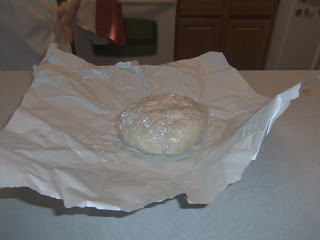The recipe was simple: butter, flour, salt and water.
I added the salt to the flour and whisked it together with a fork. It is important to have an even distribution of salt. I may have skipped this step in the past. There is nothing like biting into a nice flaky piece of pie and hitting a salt clump. Yum.
I cut the butter into small, approximately 1/2 inch, cubes before adding it to the flour mixture. The recipe calls for cold, unsalted butter. Don't let the butter sit on the counter while you are getting other things ready. Take it straight from the refrigerator, cut it up and add it. If you let it sit too long it gets mushy and hard to cut.
Really cold butter is also easier to cut into the flour with the pastry blender. I wanted to work the ingredients until I didn't have any butter flakes larger than my thumbnail (about 1/2 inch).
Recipes often describe the mixture resembling, "coarse crumbs" at this point.
 |
| Mostly I think it looks like play sand. Or bread crumbs. |
The cold water should be added 1-2 Tablespoons at a time. I used a fork to work the liquid into the flour mixture. The flour was slow to stick together but rapidly formed a nice dough as I added the last of the liquid. I only added about a 1/2 Tablespoon at a time towards the end to make sure that I didn't over water the dough.
I separated the dough into two roughly even portions. The dough stuck together just by squishing it into shape with my hands - no kneading necessary. Each portion went onto its own foil lined parchment paper. I wrapped each section in plastic wrap to prevent the pastry from drying out and then folded each up in the parchment paper.
Into the refrigerator they went. The recipe recommended refrigeration for 4-12 hours. I did this on a week night, so the dough had to wait 24 hours before I got back to it. When I unwrapped it, it was extremely solid. I was almost a little worried that I had let it get too cold.
The dough was solid. Super, super solid. I had to lean most of my weight into the rolling pin and I was still pushing really hard to get it to roll out at all.
 |
| Do my knuckles look white to you? |
I had to recruit my husband to hold onto the parchment paper so that I could use enough force to get it flat. At this point I was extremely worried. My last crust didn't go so well, and this one was felt like half-cured cement. I finally got it to the 1/8 inch thickness I was going for. After stopping for a breather and some icy-hot, it was time to put the crust in the pie plate.
My parchment paper worked perfectly - as I have come to expect from it. I set the pie plate on the crust and slipped my hand under the paper to flip both over. Then I gently peeled the paper away from the dough. I used my fingers to push it into the pie plate wherever there was an air bubble.
One Butter Flaky Crust, ready for filling.
- the Headless Cook




















No comments:
Post a Comment